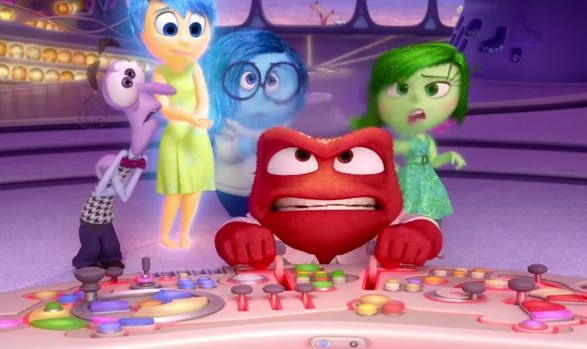Disney And Pixar's ‘Inside Out’ Brings Emotions To Life: How 5 Emotions Of The Human Brain Govern Thoughts And Actions

Do you ever look at someone and wonder, "What is going on inside their head?" The newest animated Disney/Pixar movie “Inside Out” answers that question by characterizing the emotions of an 11-year-old girl as her family moves to San Francisco. Within the headquarters of her brain, joy, anger, disgust, sadness, and fear grapple with the stress of moving by taking turns on her long-term memories, behaviors, imagination, and dreams. The movie is not far off from the dominating emotions going on inside our own brains every day.
The Brain’s Chief Emotional Drivers
Joy
What is happiness and how does it manifest differently in each of our brains? Psychology Professor Todd Kashdan tries to define happiness by looking toward other experts’ approaches. First, they look at the commonality of happiness, which is an experiential emotion at the most basic level. Happiness umbrellas joy, enthusiasm, and contentment, yet the entire emotional experience is subjective.
What brings one person joy may not be shared by your friend, coworker, parent, or partner, yet the average healthy person experiences it at some level. According to Kashdan, happiness is a state of mind, and because of that it can be measured, studied, and improved upon. Scientists have used memory measures, reaction-time computer tests, daily diaries, saliva, and brain scans to understand how happiness lives inside each of our own brains.
Anger
In the center of the brain, the anterior septum becomes active when angry. Experiencing anger is a healthy emotion; it is neither good nor bad — it’s what you do with it that matters. Research has found that only 10 percent of angry episodes result in some form of violence, which means anger does not equate to aggression. Anger typically boils up inside our brains when we assess a situation as unfair or if something blocks us from achieving a goal. Something as simple as sitting in traffic, for example, creates a hurdle to overcome on our way to reaching our goal of making it home.
But traffic isn’t the everyday driver. In fact, when scientists studied day-to-day anger throughout a calendar year, 63.3 percent of angry episodes were blamed on what other people did or didn’t do. Human interaction triggers anger more than a traffic jam or frozen computer screen ever could. A person acts on anger when the emotion builds up, indicating a perceived threat, which pushes a person to do something to stop the immediate threat before the window of opportunity to act closes.
Sadness
Different emotions cue different emotional centers to work within the brain. When an action cues you to feel sad, the brain’s activity in the amygdala begins to work — this region is associated with both arousal and fear. Happiness and sadness can take over emotional control at the same time, leading to bittersweet feelings, which are caused by independent patterns of activity, according to a study published in the American Journal of Psychiatry. Sadness, happiness, and fear all work on building blocks of pleasure, displeasure, and arousal, according to brain scans conducted with a functional magnetic resonance imaging (fMRI) machine. In extreme situations, when a person becomes chronically sad or depressed, the entire area shuts down altogether.
Sadness can improve memory and judgment too, according to research out of the University of California, Berkeley. When unpleasant emotions are triggered in the brain, a person is more likely to store memories of that moment. Conversely, during moments of happiness people are more likely to make social misjudgments. This happens because when a person is sad, their brains place more of an emphasis on collecting information and details, leading to clarity.
Disgust
Responding to a stimulus or particular object with disgust is thought to have come from the oldest and most primitive part of the human brain— the “nose brain.” Disgust helps the body avoid a perceived threat, such as poisons, contaminants, and infections. While phobias are oftentimes associated with fear, chances are they're more closely associated with disgust, which can be caused by things such as spiders, mice, blood, or seeing an injury. It protects the body from the perceived threat, and tells it to stay away through scare tactics.
Disgust is closely related to fear because it’s aroused when a person perceives a threat, according to Dr. Vijai Sharm, a psychologist trained by the National Institute of Mental Health and Neurosciences. Fear prepares the body to run while disgust prepares the body to avoid contact with the object or situation of disgust.
Fear
The body is ruled by fear if a perceived threat approaches the body. Fear releases hormones that slow down functions unnecessary for survival, such as the digestive system, and sharpens functions that will improve chances of living, such as eyesight. The brain's fight-or-flight response increases heart rate so blood can flow to the muscles faster in order to provide energy to run or defend itself. Once fear courses its way through the body, the brain short-circuits into more rational processing pathways in the amygdala, according research out of the University of Minnesota. Details are heightened in a similar way to how sadness works.
Lights, sounds, odors, time of day, weather, and other environmental details surrounding the fear-driven experience are logged into our memory. In severe cases, a person may associate unrelated situations with the memory of a dangerous situation when minute cues pop up. When the brain sees this as a similar dangerous threat, the person may be at risk of post-traumatic stress disorder (PTSD). Fear literally takes over the body in order to protect itself, and under extreme situations or chronic stress, the immune system is weakened and can cause cardiovascular damage and gastrointestinal problems, such as ulcers and irritable bowel syndrome.
Published by Medicaldaily.com



























